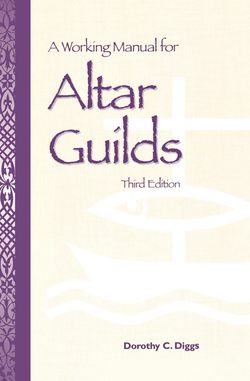Читать книгу A Working Manual for Altar Guilds - Dorothy C. Diggs - Страница 10
На сайте Литреса книга снята с продажи.
THE ALTAR
ОглавлениеIn recent years there have been radical changes in church architecture and with them have come new settings and placement of the altar. The design with which we were once familiar is the traditional church built in a cruciform shape with the altar against the east wall on a foot-pace and steps leading up to it. The communion rail separates it from the choir within the chancel, from which more steps lead down into the nave. Since some Episcopal churches still follow this pattern, most of the instructions here can be followed by them.
In building churches today the trend is to a modern design with free-standing altar in a sanctuary enclosed by the communion rail and with the nave directly adjoining—that is, without the customary choir and chancel. The choir is usually in a balcony at the rear of the church and the offices are all said in the sanctuary. Churches which have a chapel often say the Daily Offices there. Week-day celebrations of the Holy Communion as well as occasional services are also said in the Chapel.
A number of new churches now have an “altar in the round.” The altar is on a platform in the center of the sanctuary, surrounded by the communion rail, and the pews are in a circle outside this. Such an altar presents a different approach in preparing for the services.
The altar is the center of the Church's life and is the major concern of Altar Guilds. It should be vested with the greatest care and always kept in immaculate condition. By ancient custom the standard vestments of the Altar are, in this order: cerecloth, frontal and fair linen. To these may be added whatever is needed for any particular service. Instead of a frontal, some churches use a superfrontal, which is shorter and may be of the season color or simply of lace. (Lace should not be used during Advent and Lent.) Some use a frontal with superfrontal as well.
The white altar coverings should be made of linen, if possible, although synthetic materials are now often used. What the 1979 Prayer Book calls “a clean, white cloth” we have always known as “the fair linen.” The fair linen is the “fair white linen cloth” required by Prayer Book rubric. It should hang at least eighteen inches at the ends of the altar. On a solid stone or wood altar, it may hang to within a few inches of the floor. It should not touch the floor. If the altar is a table type with a recessed foundation, the fair linen should not hand much, if any, longer than eighteen inches or it will tend to ripple. Common sense should determine which length is most suitable for any particular altar.
Except when preparing for the Holy Communion, the fair linen should always be covered. If any service other than the Holy Communion is to take place, a white cloth should be put upon the fair linen, which for want of a better term may be called a prayer cover or prayer cloth. This is a white linen cloth which exactly fits the mensa, or top of the altar, and does not have ends overhanging. The reason for this cloth is that the fair linen will not long remain either “fair” or “white” if constantly exposed.
When the altar is in repose between services, it should be covered by a dust protector. This protector should completely cover the top of the altar and hang over the ends to the edge of the fair linen. It may be of virgin blue, green, or dark red, with a simple cross upon it to denote its sacred use, or it may be quite elaborate, made of a rich material with embroidery, if desired. If frontals in the colors of the Church seasons are used, a dust cover which harmonizes with these might be chosen.
There can be a difference between a free-standing altar and an altar standing free so that one may walk behind it. With either there will have to be a flexible approach to vesting it. If the altar stands out from the wall so that the priest may celebrate facing the people, the usual frontal or superfrontal may still be usable. If celebrating behind the altar is a new procedure and the six office candles have previously been used, they will have to be dispensed with. Some churches are designed with gradines or re-tables in or under the reredos. The office candles might be put there as well as the flowers. If not, the design of the sanctuary will determine what is to be done about flowers as well as the necessary adjuncts to the services.
For an “altar-in-the-round” or one on a platform on the nave floor, the traditional frontal can hardly be used. The frontal could be omitted entirely and the altar vested simply in cerecloth and fair linen with the two candlesticks. For this type of altar a Jacobean frontal, or a modified version of it, could be used. This covers the altar on all sides and hangs to the floor. Care must be taken not to use too heavy material or make the frontal too full lest it bunch up at the ends and possibly get in the way of the officiants at services.
With the coming of the new Prayer Book there has been a number of changes in procedure. Each parish priest will decide what is best for that particular congregation. Altar Guild members will follow instructions and be helpful and cooperative in order that the transition from the customary Prayer Book rite may be as easy as possible for clergy and people.
